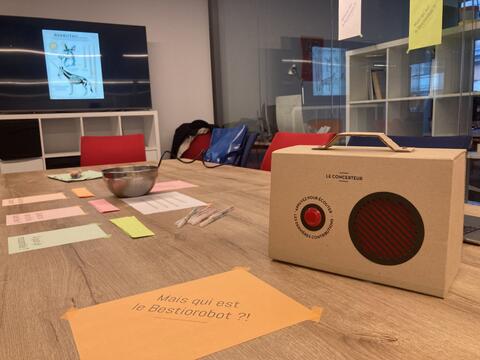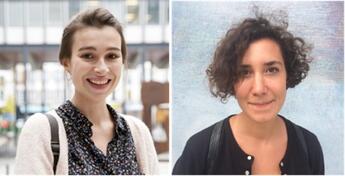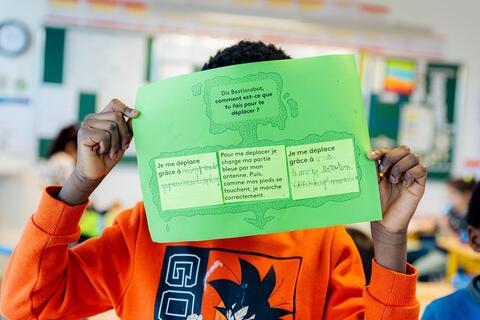
A Thousand and One Voices: an educational project on conversational technologies
Funded in part by SCAI, the "A Thousand and One Voices" project immerses high school students in the world of conversational technologies.

Initiated by designer Zoé Aegerter and Clotilde Chevet, a research engineer at SCAI and doctoral candidate at Sorbonne University, this interdisciplinary project combines design, research and pedagogy to give students the means to understand and create their own synthesized voice, while cultivating their critical thinking when faced with talking machines.
Photo: Clotilde Chevet et Zoé Aegerter
With the advent of language technologies such as voice recognition, speech synthesis and machine translation, conversational interfaces have become an integral part of our daily lives. The upheavals these technologies are causing in our relationship to reading, writing and speaking. Zoé Aegerter and Clotilde Chevet, in partnership with l’IRCAM and SCAI, are putting design in the service of education, to question these new forms of digital interfaces and enable young people to understand the issues involved.
In 2016, Clotilde Chevet, was a doctoral candidate in information and communication sciences at Sorbonne University. She met Zoé through a shared interest in the transformation these conversational technologies that are changing in our way of communicating and thinking. "I was doing research on man-machine interaction, combining communication and anthropology.” As for Zoé, she came from the field of creation and design, specializing in language technologies. We quickly realized that we shared a common vision of technology as an object of transformation. We both had a desire to cross-fertilize our fields, and that's how the Mille et une voix (A Thousand and One Voices” project was created, to become a space for both educational and creative exploration," explains Clotilde Chevet. "We wanted to answer the question: what does it mean to read, write and speak in the age of 'talking machines'?" emphasizes Zoé Aegerter. The project invites students to open the "black box" of conversational agents, to discover their inner workings, while becoming creators of these technologies themselves.
Towards actively questioning education
The central aim of "Mille et une voixA Thousand and One Voices" project is to enable young people to deconstruct and understand conversational technologies, in particular the synthesized voices that embody these talking machines. "We wanted to demystify the machine for young people, by showing them what lies behind a synthesized voice, and by engaging them in the creation of their own talking robot," Clotilde Chevet explains.
The project's ambition is to reintroduce a space of freedom and discovery into children's relationship with digital technologies, encouraging them to reappropriate the culture of data and understand their role as authors in interacting with the machine. "We felt the need to involve a young audience, as there was a challenge of acculturation to talking machines, at an age when children are acquiring skills in writing, reading and enunciation," adds Zoé Aegerter.
Making the Bestiorobot: an educational and creative approach
The heart of the project lies in the creation of the Bestiorobot, an imaginary character with a changing, plural voice, which the pupils will design through a series of workshops in partnership with Ircam. "The aim is to help the children create a talking robot whose lyrics they have written and recorded," explains Zoé Aegerter. Over the course of the workshops, the pupils discover their own recorded voice, learn how to manipulate it, and create a collective voice that embodies the Bestiorobot. "We wanted to explore the possibility of a voice that isn't unique, but embodies a collective—the children who create the robot," explains Clotilde Chevet.
Through these sessions, the children develop new skills: discovering voice synthesis, collective writing, analyzing recordings, playing with combinations, and finally creating a conversation tree. This approach enables students to understand the processes behind the technologies they use every day, while engaging them in critical reflection on these tools.

Crédit photo : Quentin Chevrier
Understanding children's relationship with talking machines
Beyond the creation of a talking robot, the "A Thousand and One Voices" project aims to observe and analyze children's perceptions of conversational robots. "We want to understand how children perceive these machines: are they magical or technological objects? Do they see themselves as designers or simply users?" explains Zoé Aegerter. To achieve this, regular discussion sessions are planned with the pupils throughout the project, to monitor the evolution of their perception and understanding of talking machines. The aim is to explore how they appropriate these technologies and use them within a creative and educational framework.
The project also looks at how they interpret their own role as authors in the creation of the robot, and how the robot learns from what the students give it. "We'll be exploring the themes of intelligence and automation: how does the robot "think" (function)? What does 'talking' or 'remembering' mean for a machine?" adds Clotilde Chevet.
The project outlook
In the short term, the project leaders aim to multiply the number of workshops in other schools, while continuing to explore a variety of formats, such as sound installations or plays in which children interact with the Bestiorobot. "We're working with composers, developers and researchers to explore all the possibilities offered by these technologies, while remaining rooted in an educational framework," explains Zoé Aegerter. This partnership also links research in digital humanities with concrete applications in schools.
The project could also extend internationally, exploring the diversity of accents and languages, particularly within the French-speaking world. "We still have a lot to explore, and we hope that this project will continue to evolve with the needs of new generations," concludes Zoé Aegerter.
